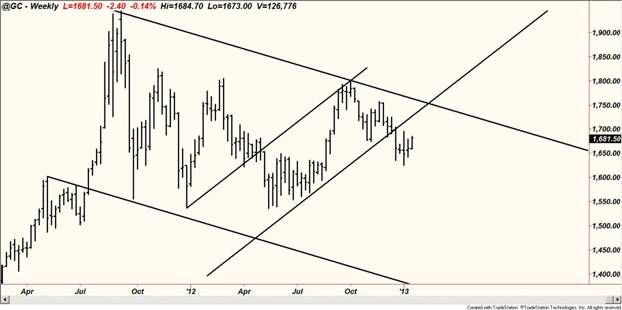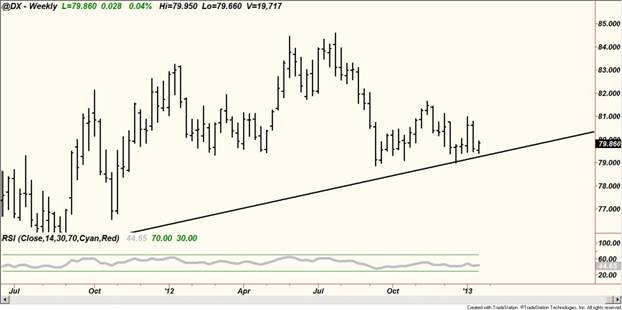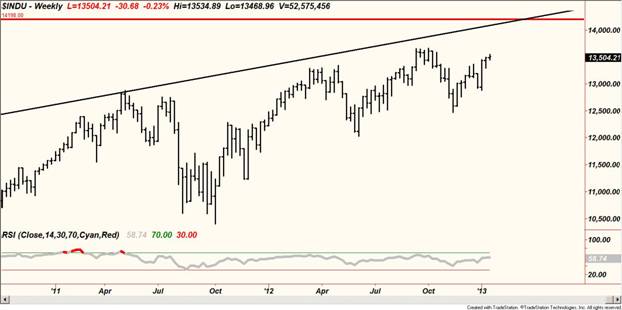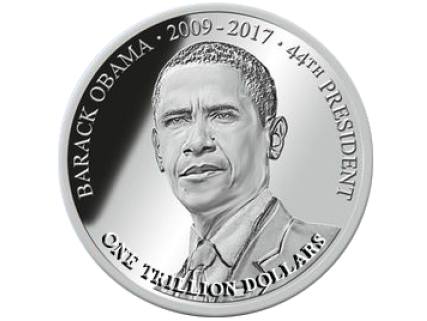Timing & trends
Produced by McIver Wealth Management Consulting Group
Neil McIver, CM, McIver Wealth Management.
Over the last couple of weeks there hasn’t been a lot of action in the markets. We continue to see very tight trading ranges that are likely due to the low volume.
But more importantly the markets are now dealing with the background noise of the second half of the fiscal cliff negotiations — the debt ceiling.
Let’s go to the charts .
Bonds Trending Lower
Bonds remain in a downtrend from their record high in price late last year and the record low in yields. And the cycles in the bond market are telling me that bond prices could plunge quite sharply in the weeks ahead.

Prices are rallying a tad, but overall the action is very weak. I expect this downtrend to continue because the bond bubble is imploding. The next stop for the 30-year Treasury bond will be at approximately the 135, 136 level. And I have almost no doubt whatsoever that we will see bonds fall and rates rise as we enter into the serious eleventh-hour negotiations on the debt ceiling.
There’s even a chance based on some of the cycles I’m looking at that Washington may not reach an agreement. And the government may have to temporarily shut down!
Gold Still Has
Room to Fall
There’s not much happening there — just a little bounce higher. You can see that we remain below an important channel resistance and below an important cyclical trend channel. We may move a little higher to just back above $1,700 to test that resistance. But look at all the air down below here!
I maintain my view that the next great buying opportunity coming in gold will be at much lower prices, most likely during the first quarter of this year.

Same Story for Silver
Silver is really just sort of climbing along this lower support level. It’s trying to rally, but the rally is very meager. Once we break the support level down around $31.25, which I fully expect, there is a steep plunge coming. So my view has not changed one bit at all.

U.S. Dollar Could Rally
The Dollar Index is acting just as I expected it to. The long-term weakness is still present in the dollar because of its inability to stage a significant rally. It’s climbing along this uptrend line. And it’s hugging it right here. We may see the dollar start to rally even as the fiscal cliff negotiations on the debt ceiling fall apart.

Now logically you might think that if we hit the debt ceiling, the government shuts down, the dollar should plunge. I don’t think that’s necessarily the case.
If you think it through, if the government shuts down, or if the budget negotiations get really nasty, a lot of investors will seek out the sidelines. They’ll get out of the markets and go to cash to wait and see what happens, which would give the dollar some strength. So it’s not a sure bet that the dollar would fall on bad news about the debt ceiling. That remains to be seen.
Short-term, the cycles still point higher for the dollar as well. Long-term, we all know the dollar is in trouble. There’s no question about it. But I don’t believe the next disastrous bear market move for the dollar will come until later this year.
Dow Industrials Holding
Up Amazingly Well
Like the dollar, the strength you’re seeing in the Dow is an indication of its long-term strength. We are, at some point in the not-too-distant future, going to enter a new bull market in equities that will see the Dow and the S&P 500 go to new record highs over the next few years.
In the short- and intermediate-term it’s a coin toss. We could see the Dow move up to just over 14,000 or we could see that long-awaited pullback that I’ve been looking for.

Fundamentally, anything could crop up that could drive the market higher or take it lower. Cyclically, on the short-term models, I’m still expecting a pullback.
So I am not willing to go all-in on the stock market yet by any means. Nor am I willing on the other side to go aggressively short at this time.
So keep your eyes on these markets. They are indeed the most frustrating I’ve seen in a long time. But I also know that when you go through periods like this, as long as you keep your ammo intact and stay defensive with your savings, when the markets start to move they are loaded with opportunities where you can make a ton of money.
Best wishes,
Larry
P.S. Did you catch Sean Brodrick’s emergency Global Energy Summit last week? It’s chock-full of expertise from industry heavyweights with “no-holds-barred” insights you won’t get anywhere else.
You won’t want to miss the surprising new trends they are seeing right now in the world’s resource markets. Get instant access to the year’s biggest energy profits and pitfalls, from the pump to your portfolio. Just click here to start watching right away!
Larry Edelson has over 34 years of investing experience with a focus in the precious metals and natural resources markets. His Real Wealth Report (a monthly publication) and Power Portfolio provide a continuing education on natural resource investments, with recommendations aiming for both profit and risk management.
For more information on Real Wealth Report, click here.
For more information on Power Portfolio, click here.
 “There have been some very important gold-related events happening over the last few years. A year ago, and more recently, I reported on the repatriation of gold by countries around the world. But now the second largest holder of gold, Germany, is apparently doing the same.
“There have been some very important gold-related events happening over the last few years. A year ago, and more recently, I reported on the repatriation of gold by countries around the world. But now the second largest holder of gold, Germany, is apparently doing the same.
Via the Telegraph: “The revelation came as Germany’s budget watchdog demanded an on-site probe of the country’s remaining gold reserves in London, Paris, and New York to verify whether the metal really exists.
The country has 3,396 tons of gold worth €143bn (£116bn), the world’s second-largest holding after the US. Nearly all of it was shifted to vaults abroad during the Cold War in case of a Soviet attack.
Roughly 66pc is held at the New York Federal Reserve, 21pc at the Bank of England, and 8pc at the Bank of France. The German Court of Auditors told legislators in a redacted report that the gold had “never been verified physically” and ordered the Bundesbank to secure access to the storage sites. It called for repatriation of 150 tons over the next three years to test the quality and weight of the gold bars. It said Frankfurt has no register of numbered gold bars. The report also claimed that the Bundesbank had slashed its holdings in London from 1,440 tons to 500 tons in 2000 and 2001, allegedly because storage costs were too high. The metal was flown to Frankfurt by air freight. The revelation has baffled gold veterans. The shift came as the euro was at its weakest, slumping to $0.84 against the dollar. But it also came as the Bank of England was selling off most of Britain’s gold reserves – at market lows – on orders from Gordon Brown.
The watchdog report follows claims by the German civic campaign group “Bring Back our Gold” and its US allies in the Gold Anti-Trust Committee that official data cannot be trusted. They allege central banks have loaned out or “sold short” much of their gold.
The refrain has been picked up by German legislators. “All the gold must come home: it is precisely in this crisis that we need certainty over our gold reserves,” said Heinz-Peter Haustein from the Free Democrats (FDP).
The Bundesbank said it had full trust in the “integrity and independence” of its custodians, and is given detailed accounts each year. Yet it hinted at further steps to secure its reserves. “This could also involve relocating part of the holdings,” it said.
There’s obviously more to this story…and we shall soon see.”
This week, news came out that Germany’s Bundesbank will indeed repatriate its gold to restore public confidence in the safety of Germany’s reserves. It will retrieve all 374 tons of the bullion it currently keeps in Paris and 300 tons currently stored at the New York Federal Reserve Bank.
The process will take 8 years and bring about 19 percent of Germany’s gold reserves back to the Fatherland. Germany holds 3,400 tons of gold reserves – the most of any country, second only to the United States.
When the process is complete, Frankfurt will hold half of Germany’s gold. New York will retain 37 percent, and London will store 13 percent.
The Bundesbank’s announcement indicates that German leaders believe the global economic crisis may soon intensify. In other words, the currency war I talked about in my past letters is heating up.
On January 15, the Telegraph’s Ambrose Evans-Prichard said that the move represents “an extraordinary breakdown in trust between leading central banks.” He compared Germany’s actions to what happened in the 1960s, when the post-war currency system fell apart and France withdrew its gold from the United States.
While the Bundesbank said they have no intention of selling gold, they did say the move is “pre-emptive” in case a “currency crisis” hits the European Monetary Union. The bank’s official news release explained the move as follows:
“With this new storage plan, the Bundesbank is focusing on the two primary functions of the gold reserves: to build trust and confidence domestically, and the ability to exchange gold for foreign currencies at gold trading centers abroad within a short space of time.”
Germany hasn’t sold gold since the 1970s and I doubt they have any intentions to.
Generally, storing so much gold domestically doesn’t make sense. If a war were to ever break out and the opposing country takes over Frankfurt, that gold is no longer theirs. So why would Germany want so much of their gold back? Are they losing faith in France? In the Fed?
This move is a clear indication of public loss of confidence on foreign central banks and the integrity of the monetary union. As I mentioned in past letters, other countries such as Venezuela, Libya, and Iran have also begun repatriating their gold holdings. They, along with Germany, are protecting themselves from the currency war at hand.
The Currency War
I have talked about currency wars in many of my past letters.
Japan’s Prime Minister Shinzo Abe has once again set the stage for a potential global currency war, announcing plans to create money and buy bonds as the government looks to stimulate their weakening economy.
However, Japan’s printing cannot be blamed solely on the country itself. When the Fed prints, other central banks have to print to keep up, or face a major decrease in their exports; thus a major decrease in economic growth. Japan has no natural resources or commodities and it relies solely on their innovation and exports for economic growth. When the Fed prints, so does the world.
Russia’s central banker Alexei Ulyukayev said that Japan is acting to weaken its currency and there is a danger that others will follow suit and foster a round of destabilising devaluations:
“We’re on a threshold of very serious, confrontational actions in the sphere that is known…as currency wars.”
In a recent article published by the Voice of Russia, it was said that Sergey Glaziev, one of the most influential advisors of the Russian president, sent a report to the Kremlin accusing both the US and EU of “legalized aggression” through unbridled monetary emission:
“As a key point of their anti-crisis policy, they (the US and EU) are refinancing their banks using negative real interest rates” and meanwhile “1.5 trillion dollars, 1.2 trillion euros and comparable amounts of yen and pounds are used to finance debt pyramids and acquire real assets across the world”.
Western banks are accused of blocking their debtors in “debt traps”, with the ultimate goal of “obtaining political control” and “seizing the real assets” of the debtors.
Sergey Glaziev considers that such a policy is actually a form of legalized aggression and that the world is in a state of financial war. According to the conclusions of this report Russia “cannot win this war” without some major changes in its own economic strategy.
Vedomosti reports that Vladimir Putin assembled a crack team of experts from Russian Academy of Science with a mission to create a brand new economic policy.
According to the Russian media, the report contains a warning regarding the risks of a global military conflict, “The conservation logic of the current financial and political system leads to a further escalation of military and political tensions, including the start of major war”.
There are solutions mentioned which serve as recommendations to avoid this outcome. A reform of the global financial system, spearheaded by Russia, is reported to be one of those solutions.”
As we are often brainwashed by domestic media, it may be difficult to see the severity and intensity of our current global financial battles. It is imperative to see the world not just from our own perspective, but from the perspective of other countries.
Russia, and many other countries, strongly believe that the continued printing of currency is leading to a worldwide restructuring of the global monetary system.
Russia and China are very big players with strong influence on global markets; Russia controls energy and China controls other commodities. Both of these countries have brilliant minds working behind the scenes to fight the current currency battles. We all need to take notice.
The rest of the world knows that currency is being printed with reckless abandon. As a result, countries around the world have begun to acquire real assets such as gold, silver, and other resource assets. Look for China and Russia to continue the mass purchases of natural resources and commodities assets around the world to spearhead a global currency regime.
If you think the commodities market is over or about to pop, think again.
Protect Yourself
I know everyone is tired of hearing about gold. It has barely moved in the last year and has bored many traders. But gold isn’t supposed to be exciting; it is serious.
Should the global currency crisis/war intensify – which it will – gold will be the last one standing. I’ve already mentioned how central banks around the world continue to buy gold. They are protecting themselves, are you?
As the People’s Bank of China official Zhang Jianhua said last month, “No asset is safe now…The only choice to hedge risks is to hold hard currency – gold.”
Silver
A few weeks ago, I told you I bought more physical silver below $30. That investment is already paying off, as silver is now showing strength and trading at nearly $32/oz. I would not be surprised to see silver move to $35 from here in short time.
Silver and gold coins continue to show buying power. Sales of American Silver Eagles for the month have already exceeded 5 million ounces and is on pace to set an all-time monthly record. However, we may not see this record breached…The United States Mint has temporarily sold out of 2013 American Eagle Silver Bullion coins…
Uranium and Oil
Over the last few weeks uranium stocks have been trading with heavy volume as Russia’s state uranium firm ARMZ moved to purchase Canada’s Uranium One Inc. in private in deal worth $2.8-billion.
Meanwhile, a 20-year agreement to decommission old Soviet warheads and convert the uranium for use in reactors is due to expire this year. This agreement currently supplies one-eighth of world uranium needs. Experts don’t expect it to be renewed which should put upward pressure on prices.
Considering that ARMZ is state-owned and has shown an eager appetite to acquire uranium deposits, I would say they know something we don’t.
In my past letter, I said that uranium will soon be back in the spotlight. The World Nuclear Association has just issued a warning that world-wide uranium demand might exceed supply next year.
Given the growing intensity of the currency war, expect to see the price of uranium – and thus uranium stocks – move higher. Oil will soon do the same; other natural resources will too.
Until next week,
Ivan Lo
Equedia Weekly

Michael Campbell Interviews Greg Weldon on January 19th’s Money Talks HERE
Greg Weldon applies intense rigor to his inter-market examinations seeking to capture the dominant secular macro-trends against the shorter-term micro-evolution taking place. He reconciles an extraordinary volume of facts with other variables such as psychology of the markets and his own intuitive insights to present a very unique and thorough publication.
This video describes our global macro research publication called Weldon’s Money Monitor. This is our flagship publication and offers a fluid combination of top-down fundamentals and bottom-up technical analysis with focus on the global economy.
We also offer TradeLab as a compliment to the Money Monitor where specific Trade idea are presented that line up with our macro themes. Feel free to sign up for a free trial here: http://www.weldononline.com/signup.aspx
Greg addresses so many markets including the Japan Yen in the Video below that Michael Campbell addressed HERE

 The talk circulating that the U.S. Treasury can circumvent the debt ceiling by minting a trillion-dollar platinum coin is pure nonsense.
The talk circulating that the U.S. Treasury can circumvent the debt ceiling by minting a trillion-dollar platinum coin is pure nonsense.
 First, to the best of my knowledge, the U.S. Treasury does not own any platinum. That means it would have to go into the market and buy up platinum to mint such a coin.
First, to the best of my knowledge, the U.S. Treasury does not own any platinum. That means it would have to go into the market and buy up platinum to mint such a coin.
But the Treasury is broke, so where would the money come from to buy the platinum?
The Federal Reserve, presumably. But I doubt the Fed is going to print another trillion dollars in one fell swoop to let the Treasury go buy 625.8 million ounces of platinum.
Yep, that’s right. It would take 625,782,227 ounces of platinum to make a trillion-dollar coin.
And even if the Treasury could come up with the money via the Fed, where would that much platinum come from?
The total global above-ground supplies of platinum are estimated to be roughly 7.5 million ounces, and the total annual production is about the same.
That means there would be about 15 million ounces of platinum available, assuming the Treasury could purchase 100% of available above-ground supplies and 100% of the production for 2013.
Even if Washington could pull off buying every single one of those above-ground ounces, it would take another 82 years of Washington buying up every single ounce of the world’s annual platinum production.
Utterly and ridiculously unrealistic, to say the least.
OK, so let’s say that $1 trillion coin has “seigniorage” in it. Its value — because it’s sovereign money — is worth more than the platinum in the coin.
And let’s say the government’s profit on the difference between the value and the cost to produce it is as high as 50% and only half the amount of platinum I just mentioned is required.
You’re still looking at 312 million ounces of platinum that would be needed. Still an utterly impossible feat to accomplish.
And then there’s another problem …
Who, or what country — in their right mind — would buy a platinum coin or coins from the U.S. Treasury knowing full well the metal is not worth a trillion dollars and that the Treasury has a large seigniorage markup on it?!
Let’s try another angle: Let’s say Washington dumps some of its gold reserves or borrows against them to buy platinum. Would that work?
Hardly. Washington owns some 287 million ounces of gold, worth roughly $474 billion. In other words, Washington would have to dump or hock our entire gold reserves.
Not going to happen.
Second, even if any of the above were logistically possible, what would it say about the U.S. and the U.S. dollar?
Minting a trillion-dollar platinum coin or even 657 million one-ounce platinum coins to pay our current debt, with more borrowed or printed money, would just send the signal that Washington is so desperate that it’s resorting to loony acts of desperation.
The dollar would plummet in value, and our government’s credibility would be toast. So would the dollar’s.
Even the platinum market doesn’t buy the idea of a trillion-dollar platinum coin. If it did, the price of platinum would be soaring, and it’s not.
Will all this nonsense lead to something else, like more talk of going back to a gold standard?
For sure, you’re going to hear a lot more about that in the months and years ahead.
But let me go on record again about a gold standard: Washington will never go back to a gold standard. Period. It robs Washington of accountability, the ability to overspend.
Nor will Europe. A gold standard is outright deflationary. If we went to a gold standard the world would collapse, like it did in the 1930s, into a massive deflationary depression.
Let me make something else perfectly clear:
In the months and years ahead you’re going to hear all sorts of nonsense, rumors and rhetoric about gold, about silver, about precious metals. 99% of it will be just that, nonsense.
Yes, gold is headed much higher over the longer term. So is silver, and so is platinum.
But the next leg up in the metals is not yet here and when it does come (from still-lower prices) it will not be due to any of the above nonsense.
It will simply be due to the fact that the governments of both Europe and the United States are flat-broke … and that there is nothing that can be done about it …
Short of all the governments of the world getting together … canceling all debts … and designing a new, debt-free-based monetary system.
It’s going to happen. The problem is that the world is going to have to go through hell to get to the other side.
Chief reason: We have leaders in Washington (and to be fair, other governments, like Europe) … and economists and analysts who are absolutely harebrained.
We passed though the eye of the hurricane last year …
And this year, the back wall of the greatest financial hurricane of all time will start to hit.
Best wishes,
Larry














